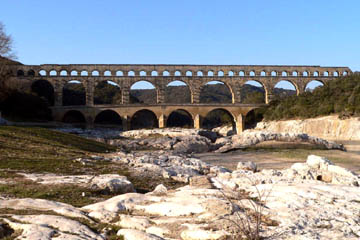Trajan's Source Discovered

|
| The amazing Pont du Gard near Nimes is a perfectly ordinary Roman aqueduct, but the splendour of its setting has made it famous. |
We see them marching across the landscape, their arches framing views or spanning roads and rivers. Some, like the fabulous Pont du Gard in the south of France, have become world famous, almost iconic in their status. Others, like the aqueduct which crosses the route to our hotel in Istanbul, are mundane and disregarded - even if, like that particular aqueduct, they are virtually a wonder of the world.
Yet, despite our familiarity with them, few stop to give a thought to where they come from. Where they go to is well-known: they ended up in a public fountain and every ancient city is littered with the remains of such installations - ornate tubs of water decorated with statuary and self-promoting inscriptions by the politician who arranged for this supply of water. In a world without running water in the homes, the public fountains at least had the merit that they were a good deal more useful than most things done by politicians!
I have a list of things that I would love to do if only I lived in an ideal world without constraints of money or time. One is to explore every staircase in Petra, another is to climb up on top of the aqueduct in Caesarea (you could, at one time; in fact there was even a staircase provided by the authorities. Now access is prohibited) and walk along it to its source. Mind you, although you can see the line of the aqueduct stretching away into the distance, I fear that is a bit of a pipe dream. At the limits of visibility you get the impression that the aqueduct is buried in sand and a quick look on Google Earth shows that it does indeed disappear under the sand dunes and then the line of the aqueduct vanishes under the modern housing units of the Jewish settlement.
Nonetheless, there are people who have traced the various aqueducts back to their sources, sometimes at astonishing distances from the cities they supplied. A previous article on this site discusses an aqueduct system several hundred miles long and individual aqueducts were commonly tens of miles long and some up in the 60 or 70 mile bracket!
People sometimes say that the Roman's built aqueducts because they didn't understand that water finds its own level. Instead of bridging a valley with an expensive aqueduct to keep the water flowing at the same level they could have built a pipe running down into the valley and up the other side. Indeed, it is even possible to cross mountains by means of an inverted pipe - it's called a syphon!
What such people fail to realise is that Roman technology had its limits. We are all familiar with the problems faced by divers when they descend beneath the sea and encounter water pressure. Even your expensive Rolex is probably only waterproof to 100'! The Romans could have made thick lead pipes to withstand the pressure of water at the bottom of a 100' deep valley, but that much lead would have been more expensive than a stone aqueduct and the problems of making watertight joints between the short lead pipe sections were insurmountable.
And so the Romans built aqueducts and we continue to be amazed by them. The most recent amazing discovery was made in 2009 by a father and son team of film makers, Michael and Edward O'Neill, who were making a documentary in the Lake Bracciano region north of Rome about another aqueduct. Locals told them about an aqueduct that started beneath the abandoned church of Santa Fiore, but dated it to the 18th century. Fortunately someone on the film crew knew enough about aqueducts to be able to tell the difference between 18th century stonework and Roman masonry.
The film makers summoned Lorenzo Quilici, an expert on aqueducts, and guided him through the undergrowth to the church and beneath it to a 30' deep chamber into which water flowed from several natural sources in the area. From the chamber a tunnel led off and the water was still flowing through it! (In fact, the aqueduct still supplies water to Rome.) The tunnel has been explored for nearly 400', but unfortunately fig trees growing above it have sent down roots that penetrate the roof and have brought about partial collapse.
One of the exciting things about this new discovery is that the vaulted roof of the collecting chamber is painted with Egyptian Blue. Painting it at all is not necessary to the functioning of the aqueduct and painting it with such an expensive pigment can only mean that the Emperor Trajan was present - probably for the opening ceremony when his great aqueduct was inaugurated.
Unfortunately, despite the media hype, the two have not made an original discovery. The source of the aqueduct was documented as recently as 1935 and it was a reference to it in "The Aqueducts of Ancient Rome" by Thomas Ashby, director of the British School at Rome from 1906 to 1925, that led the pair to the area. Still, the hype has had one good effect: two American scholars, Katherine Rinne of the University of Virginia and Rabun Taylor of the University of Texas at Austin, who were working on another aqueduct in the vicinity, are actively looking for funding to examine the find in greater detail.
In addition the tourist authorities are talking about the possibility of restoring the aqueduct - getting rid of the fig tree roots and repairing the ceiling - and making it accessible to tourists. If you have ever longed to wade through waist-deep water along a low, narrow tunnel in total darkness, keep your fingers crossed. Your time may be at hand.
© Kendall K. Down 2010





